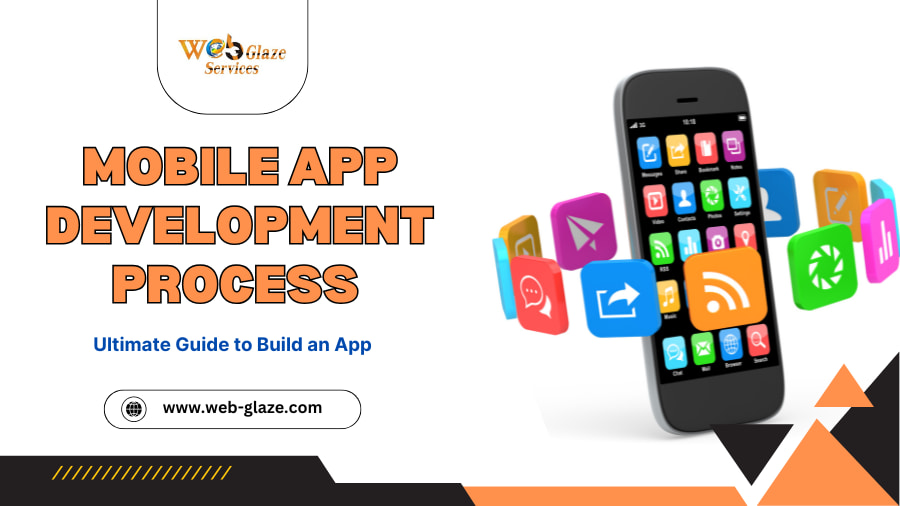Mobile App Development Process – Ultimate Guide to Build an App

Understanding the mobile app development process is essential for any company hoping to stay ahead of the competition and provide outstanding user experiences in today’s digital first world. This Mobile App Development Process guide will guide you through every step, from ideation to post-launch support, whether you’re a startup launching your first product or an enterprise looking to modernize operations. We’ll go over best practices, give an example of mobile application development, and show you how working with professionals like Web Glaze Services can help you realize your idea.
Table of Contents
The Process for Mobile App Development

1. Ideation & Market Research
Every successful app starts with a small idea. In this first stage, you ought to –
- Establish Your Objectives – Identify the issue you’re trying to solve or the benefit you’re providing. Are you starting a new revenue stream, optimizing internal processes, or increasing customer engagement?
- Examine the Market – To confirm demand, perform user surveys and competitor analyses. An efficient mobile app development process starts with an understanding of user pain points and feature gaps.
- Construct User Personas – In order to prioritize features that appeal to your target audience, create thorough profiles that include information about your age, occupation, and behaviors. This is a crucial step in the mobile application development for businesses.
2. Planning & Documentation
After your idea has been proven to work, formalize it with thorough planning –
- Collecting Requirements – Create a thorough specification document that covers technical limitations, functional requirements, and user stories. This acts as your guide during the entire Mobile Application Development Process.
- Selection of the Technology Stack – Choose between cross-platform (Flutter, React Native), native (Swift/Kotlin), or hybrid frameworks. Performance, time-to-market, and long-term maintenance will all be impacted by your decision.
- Project Schedule & Approximations – Divide the development process into sprints and milestones. Calculate the budgets, schedules, and resources needed for each stage of your mobile app development process.
3. UI/UX Design
The success of any app is largely dependent on the user experience. In this stage –
- Wireframing – To map screen hierarchies and user flows, create low-fidelity layout sketches. Iteration is facilitated by tools such as Sketch or Figma.
- Mockups with High Fidelity – Create slick screens that use the color scheme, typeface, and icons of your brand. Make sure all devices are accessible and consistent.
- Engaging Prototypes – Make clickable demonstrations that mimic actual interactions. Before a single line of code is written, stakeholders can experience the flow with this mobile application development example.
4. Development & Coding
Development begins after designs are approved –
- Configuring Environments – Set up the environments for development, staging, and production. Collaboration and code quality are guaranteed by continuous integration pipelines and version control (Git).
- Development of Backends and APIs – Construct scalable and secure server-side components. Your APIs must reliably manage data storage, authentication, and third-party integrations regardless of whether you’re using Ruby on Rails, Node.js, or.NET.
- Implementation of Frontend – Convert designs into screens that are performant and responsive. For smooth experiences, make use of platform-specific optimizations, such as Android Jetpack Compose or iOS Auto Layout.
- Trends in Custom Mobile App Development for 2025 – Anticipate the emergence of 5G-optimized real-time apps, edge computing for low-latency interactions, and deeper integration of AI/ML features in 2025. Make sure these new technologies can be incorporated into your architecture.
5. Quality Assurance & Testing
No App Development Services engagement can compromise on rigorous testing –
- Unit and Integration Tests – To verify individual parts and how they work together, developers create automated tests.
- UI/UX Testing – To confirm accessibility features, animations, and touch gestures, QA engineers run both manual and automated tests (such as Appium).
- Performance and Security Audits – While vulnerability scans and penetration tests safeguard user data and adhere to laws like the CCPA and GDPR, load testing guarantees that the application can grow.
- Beta Testing – Release to a limited number of actual users through Google Play Internal Testing or TestFlight (iOS) is known as beta testing. Prior to the official launch, get input and fix any usability problems.
6. Deployment & App Store Submission
When you launch your app, you must –
- Getting Store Assets Ready – Make eye-catching screenshots, promotional videos, and app icons. Create a listing on Google Play and the App Store using relevant keywords to increase discoverability.
- Compliance & Guidelines – To prevent rejections or delays, follow platform policies, such as Google’s Developer Program Policies and Apple’s Human Interface Guidelines.
- Release Strategy – To track crash rates and user feedback, think about implementing a phased rollout. Staged releases can be automated with tools like Firebase App Distribution.
7. Post-Launch Support & Maintenance
After launch, a successful Mobile App Services engagement continues –
- Analytics & Monitoring – Track user behavior, retention, and conversion funnels by integrating analytics platforms (such as Mixpanel and Firebase Analytics).
- Constant Improvement – Update your app frequently in response to user input, industry trends, and performance metrics. Introducing minor feature improvements and fast bug fixes keeps users interested.
- Planning for Scalability – Make sure your CI/CD pipeline supports dependable, fast releases and that your backend can auto-scale as your user base expands.
Real-World Mobile Application Development Example

Take the e-commerce startup, which used the following mobile app development process –
1. Research and Ideation – Found a need for hyper-local same-day delivery.
2. Planning – Firebase was selected for backend services and Flutter for quick cross-platform development.
3. Design – Developed interactive prototypes with a focus on one-tap checkout.
4. Development – Integrated Twilio for OTP verification, built modular codebases, and integrated Stripe for payments.
5. Testing – A beta with 500 users and more than 300 automated tests were carried out.
6. Launch – With focused App Store optimization, 50,000 downloads were made in the first month.
7. Maintenance – To increase the average order value by 20%, AI-driven recommendation engines were added in later releases.
This Mobile Application Development example shows how an organized procedure can turn an idea into a product that leads the market.
Choosing The Right Partner – Why Web Glaze Services?

It takes domain knowledge, technical skill, and a team mentality to start a mobile application development project for a business. Web Glaze Services provides –
End-to-End App Development Services – We manage every facet of your project, from the original concept to continuing upkeep.
1. Tailored Solutions – Our teams specialize in Custom Mobile App Development 2025, whether you require a basic MVP or a sophisticated enterprise-grade platform.
2. Agile Methodology – We ensure transparency and quick feedback cycles by delivering incremental value in sprints.
3. Cross-Industry Experience – We have experience in retail, healthcare, finance, and logistics, which enables us to address particular problems and incorporate industry best practices.
4. Committed Support – Following the launch, our staff offers round-the-clock performance optimization, feature road mapping, and monitoring.
By collaborating with Web Glaze Services, you can take advantage of their demonstrated expertise in providing mobile app services and app development services to realize your digital roadmap.
Conclusion
The process of developing a mobile app is a complex one that combines technical precision, strategic planning, and creativity. You can reduce risks, maximize expenses, and produce a unique product that users will love by adhering to the above-described structured mobile application development process. Every stage is essential to the success of your app, from conception and design to post-launch optimization and Custom Mobile App Development 2025 trends.
When you’re prepared to turn your idea into a captivating, high-performing mobile application, contact Web Glaze Services, the professionals in Mobile Application Development for Businesses. Your journey from concept to app store bestseller is only a conversation away with our all-inclusive app development services and dedication to quality.




